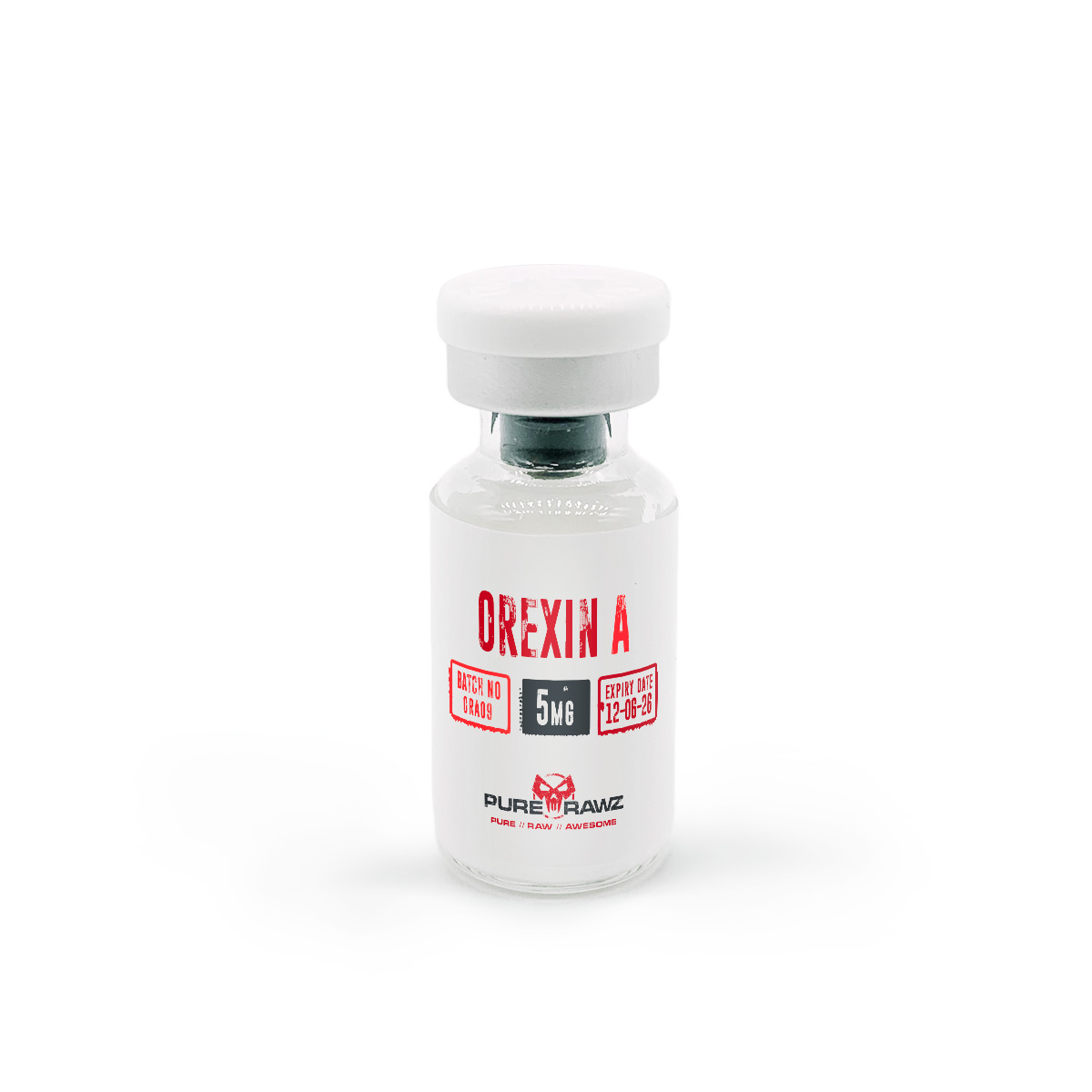Overview
Regulation of sleep-wake cycles and appetite is like maintaining a symphony in your body. Imagine your body as an intricate orchestra, and sleep-wake cycles and appetite are the rhythm section. If the timing gets off, the whole performance suffers. In essence, regulating these cycles is like conducting a well-orchestrated performance, ensuring each note is played at the right time and in harmony. Thankfully, we have a supplement known as Orexin A to keep both these cycles in check.
Introduction
Orexin A, also called hypocretin-1, is a neuropeptide produced in the brain regions called the hypothalamus. The term is derived from “orexis,” the Greek word for appetite, highlighting its role in regulating feeding behavior and wakefulness. Orexin A is part of a family of peptides that includes Orexin B, and both are primarily associated with the regulation of sleep-wake cycles and appetite.
Orexin A – Product Information:
Commonly referred to as orexin hypocretin, this neuropeptide occurs naturally in humans, rats, and mice. This compound is produced in the hypothalamus and plays a critical role in various physiological processes in the body. Orexin A and B (also called hypocretin 1 and hypocretin 2) were first identified in 1998 by two separate groups via two different approaches ( Alexander et al ., 2011; de Lecea et al ., 1998; Sakurai et al ., 1998 ).
One of the significant functions of Orexin A is its impact on the amygdala, a part of the brain that regulates emotions. This interaction not only promotes wakefulness but also aids in regulating sleep-wake cycles. Its binding mechanism is of particular interest, especially in cases of orexin deficiency, such as narcolepsy. {R}
In addition to chronic daytime sleepiness, narcolepsy affects momentary loss of muscle tone (cataplexy) due to a deficient orexin system and a low level of orexins in the brain and cerebrospinal fluid. It also affects feeding behavior, energy metabolism, and appetite regulation. As a product, this compound is orally bioavailable, has good brain penetrance, and demonstrates orexin receptor occupancy in rat brain (in various rodent studies).
Orexin A – How Does It Work?
Activation of Receptor Antagonists
Orexin A exerts its effects by binding to and activating two G protein-coupled receptors namely ox1r and ox2r. These two receptors belong to the family of hypothalamic neuropeptides and are primarily located in the central nervous system, including the hypothalamus. {R}
Image source: https://en.wikipedia.org/wiki/Orexin
Effects on Brain’s Hypothalamus
One of the primary functions of the compound is to promote wakefulness and arousal. It acts on orexin receptors in the lateral hypothalamus, specifically in the wake-promoting areas. It stimulates the release of neurotransmitters such as norepinephrine, serotonin, and histamine, contributing to increased alertness and wakefulness. {R}
Appetite Regulation
It is also involved in the regulation of feeding behavior and appetite as it acts in the hypothalamus, where it influences neurons that control hunger and satiety. It stimulates the release of neuropeptides involved in appetite stimulation, leading to increased food intake. {R}
Brain’s Reward Pathways
The orexin system is implicated in the brain’s reward pathways. The compound influences the release of neurotransmitters associated with reward and motivation, contributing to behaviors related to seeking rewarding stimuli.
Dysregulation of the orexin system, including orexin deficiency, is associated with sleep disorders such as human narcolepsy. Narcolepsy is characterized by excessive daytime sleepiness and abnormal transitions between wakefulness and rapid eye movement (REM) sleep.
Orexin A – Benefits
Also known as hypocretin-1, it is a neuropeptide that plays a crucial role in regulating various physiological processes. Here are some of the potential benefits associated with its functions:

1. Wakefulness and Alertness:
Orexin A is a key regulator of wakefulness and arousal. It helps promote and maintain wakefulness during the day, making it a potential target for conditions associated with excessive daytime sleepiness. {R}
2. Appetite Regulation:
It is best known for regulating feeding behavior and appetite. It stimulates hunger and the motivation to seek and consume food. Research in this area suggests that it may play a role in energy homeostasis. {R}
3. Mood and Motivation:
The orexin system is implicated in the brain’s reward pathways. The compound produces motivation, reinforcement, and the perception of reward. Dysfunction in the orexin system produces mood disorders and conditions such as depression. {R}
4. Stress Response:
The compound positively affects the body’s response to stress. It modulates the release of stress hormones and may contribute to the overall stress response. Understanding the role of this compound in stress physiology could have implications for stress-related disorders. {R}
5. Thermoregulation:
The compound has been associated with the regulation of body temperature. It plays a role in thermoregulation, helping the body maintain a stable internal temperature in response to environmental changes. {R}
6. Potential Therapeutic Applications:
Research into hypocretin orexin and its receptors has led to investigations into potential therapeutic applications. Targeting the orexin system may have implications for conditions such as sleep disorders (narcolepsy), obesity, and mood disorders. Developing drugs that modulate orexin receptors could offer new treatment options. {R}
Moreover, the drug has shown protective effects in vitro models of dopaminergic neurons in Parkinson’s disease as well.
Side Effects
Since it is an endogenous substance, like all other medications, peptides may have associated side effects. Responses to any drug or therapeutic intervention can vary among individuals. Genetic, physiological, and environmental factors can influence how a person responds to a substance.
Some rat studies suggest that the compound may cause respiratory issues but since orexin knockout mice have relatively normal baseline ventilation in those studies, it seems unlikely that orexin receptor antagonists would significantly reduce respiratory drive. However, potential interactions with other medications or alcohol need caution.
Legal Status:
The FDA has already approved three drugs – suvorexant, lemborexant, and daridorexant – that target the orexin receptors for treating insomnia. However, several other orexin receptor antagonists are currently being investigated for their potential to treat insomnia in Alzheimer’s disease, suppress appetite in obesity, and alleviate a range of mental health conditions, such as depression, drug dependence, panic disorder, and posttraumatic stress disorder.
Dosage:
When taking this medicine, following the directions provided on the package or as directed by your doctor is important. Typically, it is taken orally once a day. If the brand of medicine contains vitamin C, take it with a full glass of water (8 ounces/240 milliliters).
Where to Buy Orexin Online?
The quality of the supplements can vary between brands. Choose products from reputable manufacturers, and consider consulting with a healthcare professional to guide selecting a high-quality supplement.
We recommend Pure Rawz as the best place to buy “orexin a”. Pure Rawz provides it in lyophilized powdered form in a dose bottle of 5mg to its customers. To be the best supplier of research chemicals, the online store provides reference materials with every product they sell.

Conclusion:
Our body produces Orexin A naturally as a result of the processing of its precursor molecule, prepro-orexin. These neuropeptides are synthesized primarily in a specific region of the hypothalamus and play a vital role in modulating various neural circuits. Humans and cows have naturally occurring Orexin A, indicating its relevance across species. This neuropeptide’s involvement in energy homeostasis and its connection to various physiological and neurological functions make it an area of ongoing scientific research.


